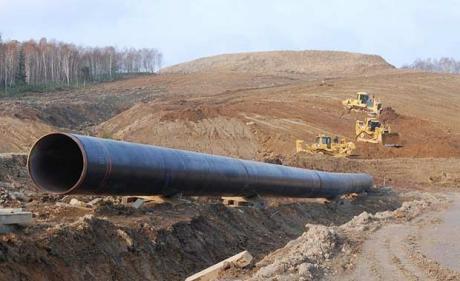
Southern Gas Corridor Risks Loss Of Strategic Focus
Publication: Eurasia Daily Monitor Volume: 8 Issue: 38
By:

“Achieving the objectives of the Southern Corridor,” in the European Commission’s phrase (EurActiv, February 19), implies commitment to its strategic purpose. This is to supply countries along the Nabucco project’s route, from Bulgaria to Austria and Germany, with Caspian gas, thus reducing those countries’ dependence on Gazprom. This purpose would be diluted or negated if the gas flow is dispersed and redirected to other markets, in Italy for example, that are already saturated and highly diversified with gas supplies. Postponement of the Nabucco project’s final investment decision by yet another year poses the risk of diluting the Southern Corridor’s strategic focus, bringing instead the corridor’s non-strategic components to the fore.
The proposed Interconnector Turkey-Greece-Italy (ITGI, involving Italian Edison and Greek Depa/Desfa) and Trans-Adriatic Pipeline to Italy (TAP, involving Norwegian Statoil, Swiss EGL, and German Ruhrgas) are relatively small-capacity projects at 10 billion cubic meters (bcm) per year for each, with Italy as the primary target of both projects. Unlike Nabucco, they are inherently non-strategic when considered individually. ITGI and TAP are corporate business projects in their own right, as distinct from strategic European projects. As business projects they seem somewhat redundant in relation to each other: both compete over the Shah Deniz Phase Two of gas production in Azerbaijan; both are targeting the same saturated market in Italy; and both propose to use Turkey’s pipeline system, with its limited spare capacities, to reach Greece en route to Italy (EDM, January 14).
TAP enjoys the unique advantage of Statoil being a major stakeholder in the Shah Deniz producers’ consortium. However, TAP displays potential disadvantages: two main stakeholders from outside the European Union (minority stakeholder Ruhrgas being recently added for a bridgehead in the EU); the proposed TAP storage site in Albania (again strategically irrelevant from a European perspective); and Greek discomfort with TAP routing its pipeline via Albania, en route from Greece to Italy. TAP’s driving force, Statoil, insists from outside the EU for equal treatment of TAP and Nabucco by the European Commission (European Energy Review, January 3).
ITGI, with an estimated cost of $2.5 billion to build the missing links, claims a big cost advantage over the Nabucco project’s costs (“Cost And Supply Issues Delay The Nabucco Project,” EDM, February 24). This advantage, however, is largely a consequence of ITGI not planning to build an independent trunkline in Turkey. The ITGI and TAP propose to use Turkey’s pipeline system for transporting their hoped-for gas volumes westward, at some technical and commercial risk. Ultimately, this might turn into a swap operation, rather than direct access for Caspian producers to Europe (albeit to a minor niche there).
Nabucco’s costs are commensurate with its planned capacity, which is thrice that of ITGI, so as to accommodate multiple sourcing of gas, including that from Turkmenistan and northern Iraq. From the European consumers’ perspective, Nabucco’s multiple sourcing is a significant advantage in reducing risks and enhancing supply security. Only Nabucco would build a new pipeline on Turkish territory, to exist separately from Turkey’s pipeline grid, and opening direct access to Europe for Azerbaijan and Turkmenistan. Under the inter-governmental agreement, Nabucco is immune to interference by the Turkish government and the Botas pipeline operator (this might not apply on the feeder line from northern Iraq to the Nabucco trunkline, if the Nabucco consortium uses the existing Turkish lines, rather than building its own).
Nabucco’s immunity is attractive to Caspian gas producers, considering Ankara’s negotiating record on transit issues. Nabucco offers a unitary legal and regulatory regime all the way to European Union territory, unlike ITGI and TAP. Thus, on the whole, “savings” resulting from not building a new trunkline in Turkey, and operating with non-strategic volumes, cannot convincingly be presented as competitive advantages over the Nabucco project.
Publicly at least, ITGI’s management seems more active than TAP’s in suggesting some division of tasks with the Nabucco project, or points of compatibility with it. Thus, ITGI proposes implementing the Southern Corridor in two phases. The first phase would consist of ITGI’s own pipeline project, carrying Azerbaijani gas via Turkey and Greece to Italy. As a small sop to Azerbaijan, the ITGI consortium would build a spur from Greece into Bulgaria. Only the second phase would involve the Nabucco pipeline, in the expectation of larger gas volumes becoming available from new sources at that later stage (EurActiv, February 18).
This clearly implies a pre-emptive role for ITGI, blocking Nabucco’s first stage for several years, delaying its second stage indefinitely, and closing the gateway for Turkmen gas to Europe. It would be a “Southern Corridor” in name only. The notion of developing the Southern Corridor through small “building blocks,” starting with ITGI and/or TAP, lacks credibility. These niche projects cannot accommodate Turkmen gas in volumes that would encourage Turkmenistan to participate. Only Nabucco can open the access for Turkmen gas through the Southern Corridor to Europe.
Once this takes place, those volumes on top of Azerbaijani gas volumes could move through Nabucco, ITGI, and TAP. Significant niches are open for the latter two projects within the EU’s Southern Corridor strategy, rather than in separation from that strategy. The sequencing, however, is decisive. ITGI and TAP can find their raison d’etre as Southern Corridor components, once Nabucco opens the way for gas from Turkmenistan and possibly northern Iraq to Europe.




